A Deformation Reconstruction Strategy for Integrated Truss Structures Subjected to Thermal–Mechanical Load
Abstract
1. Introduction
2. Deformation Reconstruction Method for ITSs
3. Numerical Scenarios
3.1. Numerical Model
3.2. Load Scenarios
4. Results and Discussion
4.1. Reconstruction Results in Mechanical Loads
4.2. Reconstruction Results in the Thermal–Mechanical Load
5. Conclusions
- (1)
- The proposed strategy effectively reconstructs ITSs deformations under complex load conditions. For the primary truss structure, the method accurately captures bending deformations of three trusses in both principal directions across all studied load scenarios. The maximum error based on the root mean square is limited to 2.28 mm, with a displacement of 225 mm, demonstrating high reconstruction accuracy. For flat panel structures mounted to trusses with two-point fixed boundaries, the least square optimization successfully solves the integral equation for deflection curves even with unknown initial values. This approach enables accurate one-dimensional deflection curve reconstruction, which serves as a basis for generating displacement field contour plots. The maximum error for panel reconstruction is only 3.10 mm, highlighting the potential of the proposed strategy for in-orbit deformation monitoring and reconstruction.
- (2)
- Under thermal–mechanical loads, structural stress and strain distributions become more intricate compared to purely mechanical loads, resulting in an oscillatory bending deformation mode for trusses. To enhance the accuracy of the deformation reconstruction in such scenarios, reducing sensor spacing or employing higher-order interpolation functions to model strain distributions more accurately may be necessary.
Author Contributions
Funding
Institutional Review Board Statement
Informed Consent Statement
Data Availability Statement
Conflicts of Interest
Abbreviations
| ITS | integrated truss structures |
| FBG | Fiber Bragg Grating |
| DOF | degree of freedom |
| iFEM | inverse finite element method |
| BP | back propagation |
| MPC | multiple-point constraints |
| RMS | root mean square |
References
- Ma, X.; Li, T.; Ma, J.; Wang, Z.; Shi, C.; Zheng, S.; Cui, Q.; Li, X.; Liu, F.; Guo, H.; et al. Recent advances in space-deployable structures in China. Engineering 2022, 17, 207–219. [Google Scholar] [CrossRef]
- Ma, X.; An, N.; Cong, Q.; Bai, J.B.; Wu, M.; Xu, Y.; Zhou, J.; Zhang, D.; Zhang, T.; Guo, R.; et al. Design, modeling, and manufacturing of high strain composites for space deployable structures. Commun. Eng. 2024, 3, 78. [Google Scholar] [CrossRef]
- Feng, Y.; Ma, X.; Li, Y. Review of thermally-induced dynamic response of large space structures. Space Electron. Technol. 2020, 17, 13–21. [Google Scholar]
- Hwu, S.U.; Panneton, R.J. Truss Structure Effects on International Space Station Global Positioning System Antenna Performance. J. Spacecr. Rocket. 1998, 35, 409–411. [Google Scholar] [CrossRef]
- Shi, Z.; Zhou, Q.; Zhu, H.; Yang, W.; Meng, N. Thermal-dynamic coupling analysis of space truss antennas in actual space thermal environment. Eng. Struct. 2024, 298, 117020. [Google Scholar] [CrossRef]
- Beals, G.A.; Crum, R.C.; Dougherty, H.J.; Hegel, D.K.; Kelley, J.L.; Rodden, J.J. Hubble Space Telescope precision pointing control system. J. Guid. Control Dyn. 1988, 11, 119–123. [Google Scholar] [CrossRef]
- Kopsaftopoulos, F.P.; Fassois, S.D. Vibration based health monitoring for a lightweight truss structure: Experimental assessment of several statistical time series methods. Mech. Syst. Signal Process. 2010, 24, 1977–1997. [Google Scholar] [CrossRef]
- Zhang, Z.; Zheng, S.; Li, H.; Ren, L. Deflection Estimation of Truss Structures Using Inverse Finite Element Method. Sensors 2023, 23, 1716. [Google Scholar] [CrossRef]
- Luo, Z.; Li, J.; Hong, G.; Li, H. Strain-based displacement field reconstruction method for thin rectangular plate through orthogonal deflection curves bridging. Struct. Control Health Monit. 2020, 27, e2457. [Google Scholar] [CrossRef]
- Zhao, F.; Bao, H.; Zhang, F. Geometrically nonlinear deformation reconstruction of based on Euler–Bernoulli beam theory using a nonlinear iFEM algorithm. Thin-Walled Struct. 2023, 189, 110884. [Google Scholar] [CrossRef]
- Zhu, L.; Sun, G.; Bao, W.; You, Z.; Meng, F.; Dong, M. Structural deformation monitoring of flight vehicles based on optical fiber sensing technology: A review and future perspectives. Engineering 2022, 16, 39–55. [Google Scholar] [CrossRef]
- Kwon, H.; Park, Y.; Kim, J.H.; Kim, C.G. Embedded fiber Bragg grating sensor–based wing load monitoring system for composite aircraft. Struct. Health Monit. 2019, 18, 1337–1351. [Google Scholar] [CrossRef]
- Wang, W.; Lu, Y.; Zhao, D.; Zhang, J.; Bai, X. Research on large deflection deformation reconstruction of elastic thin plate based on strain monitoring. Measurement 2020, 149, 107000. [Google Scholar] [CrossRef]
- Thomas, J.; Gurusamy, S.; Rajanna, T.R.; Asokan, S. Structural shape estimation by mode shapes using fiber Bragg grating sensors: A genetic algorithm approach. IEEE Sens. J. 2019, 20, 2945–2952. [Google Scholar] [CrossRef]
- Wang, X.; Si, C.; Wang, Z.; Li, Y. Displacement field reconstruction of structures under thermal and mechanical loading environment. Aerosp. Sci. Technol. 2021, 117, 106914. [Google Scholar] [CrossRef]
- Kim, H.I.; Kang, L.H.; Han, J.H. Shape estimation with distributed fiber Bragg grating sensors for rotating structures. Smart Mater. Struct. 2011, 20, 035011. [Google Scholar] [CrossRef]
- Foss, G.C.; Haugse, E.D. Using modal test results to develop strain to displacement transformations. In Proceedings of the 13th International Modal Analysis Conference, Nashvile, TN, USA, 13–16 February 1995; Volume 2460, p. 112. [Google Scholar]
- Rapp, S.; Kang, L.H.; Han, J.H.; Mueller, U.C.; Baier, H. Displacement field estimation for a two-dimensional structure using fiber Bragg grating sensors. Smart Mater. Struct. 2009, 18, 025006. [Google Scholar] [CrossRef]
- Kang, L.H.; Kim, D.K.; Han, J.H. Estimation of dynamic structural displacements using fiber Bragg grating strain sensors. J. Sound Vib. 2007, 305, 534–542. [Google Scholar] [CrossRef]
- Tessler, A.; Spangler, J.L. Inverse FEM for full-field reconstruction of elastic deformations in shear deformable plates and shells. In Proceedings of the 2nd European Workshop on Structural Health Monitoring, Munich, Germany, 7–9 July 2004. [Google Scholar]
- Tessler, A.; Spangler, J.L. A least-squares variational method for full-field reconstruction of elastic deformations in shear-deformable plates and shells. Comput. Methods Appl. Mech. Eng. 2005, 194, 327–339. [Google Scholar] [CrossRef]
- You, R.; Ren, L. An enhanced inverse beam element for shape estimation of beam-like structures. Measurement 2021, 181, 109575. [Google Scholar] [CrossRef]
- Ding, G.; Yan, X.; Gao, X.; Zhang, Y.; Jiang, S. Reconstruction of propeller deformation based on FBG sensor network. Ocean Eng. 2022, 249, 110884. [Google Scholar] [CrossRef]
- Abdollahzadeh, M.A.; Ali, H.Q.; Yildiz, M.; Kefal, A. Experimental and numerical investigation on large deformation reconstruction of thin laminated composite structures using inverse finite element method. Thin-Walled Struct. 2022, 178, 109485. [Google Scholar] [CrossRef]
- Zhao, Y.; Du, J.; Bao, H.; Xu, Q. Optimal Sensor Placement for Inverse Finite Element Reconstruction of Three-Dimensional Frame Deformation. Int. J. Aerosp. Eng. 2018, 2018, 6121293. [Google Scholar] [CrossRef]
- Zhao, F.; Guo, Y.; Bao, H. Shape sensing of the thin-walled beam members by coupling an inverse finite element method with a refined quasi-3D zigzag beam theory. Thin-Walled Struct. 2024, 202, 112127. [Google Scholar] [CrossRef]
- Kefal, A.; Oterkus, E.; Tessler, A.; Spangler, J.L. A quadrilateral inverse-shell element with drilling degrees of freedom for shape sensing and structural health monitoring. Eng. Sci. Technol. Int. J. 2016, 19, 1299–1313. [Google Scholar] [CrossRef]
- Gherlone, M.; Cerracchio, P.; Mattone, M. Shape sensing methods: Review and experimental comparison on a wing-shaped plate. Prog. Aerosp. Sci. 2018, 99, 14–26. [Google Scholar] [CrossRef]
- Gherlone, M.; Cerracchio, P.; Mattone, M.; Di Sciuva, M.; Tessler, A. Shape sensing of 3D frame structures using an inverse finite element method. Int. J. Solids Struct. 2012, 49, 3100–3112. [Google Scholar] [CrossRef]
- Zhao, F.; Bao, H.; Liu, J.; Li, K. Shape sensing of multilayered composite and sandwich beams based on Refined Zigzag Theory and inverse finite element method. Compos. Struct. 2021, 261, 113321. [Google Scholar] [CrossRef]
- Cerracchio, P.; Gherlone, M.; Di Sciuva, M.; Tessler, A. A novel approach for displacement and stress monitoring of sandwich structures based on the inverse Finite Element Method. Compos. Struct. 2015, 127, 69–76. [Google Scholar] [CrossRef]
- Ko, W.L.; Richards, W.L.; Tran, V.T. Displacement Theories for In-Flight Deformed Shape Predictions of Aerospace Structures; Technical Report; NASA Dryden Flight Research Center: Kern County, CA, USA, 2007. [Google Scholar]
- Cheng, J.; Lu, H.; Xie, F.; Zhu, P. Structural Deformation Reconstruction of Polymer Distributed Optical Fiber Sensing Tape Based on Ko Theory. J. Phys. Conf. Ser. 2022, 2366, 012016. [Google Scholar] [CrossRef]
- Ding, G.; Yue, S.; Zhang, S.; Song, W. Strain-deformation reconstruction of CFRP laminates based on Ko displacement theory. Nondestruct. Test. Eval. 2021, 36, 145–157. [Google Scholar] [CrossRef]
- Xing, S.; Zhou, X.; Huang, Q.; Zhou, Z.; Wang, L. Beam deformation reconstruction based on Ko displacement theory. Measurement 2024, 238, 115324. [Google Scholar] [CrossRef]
- Wu, H.; Dong, R.; Liu, Z.; Wang, H.; Liang, L. Deformation monitoring and shape reconstruction of flexible planer structures based on FBG. Micromachines 2022, 13, 1237. [Google Scholar] [CrossRef]
- Yan, J.; Du, H.; Bu, Y.; Jiang, L.; Xu, Q.; Zhao, C. Data-Driven Method for Real-Time Reconstruction of the Structural Displacement Field. J. Aerosp. Eng. 2024, 37, 04024028. [Google Scholar] [CrossRef]
- Ding, G.; Jiang, S.; Zhang, S.; Xiao, J. Strain-deformation reconstruction of carbon fiber composite laminates based on BP neural network. Mater. Res. 2019, 22, e20190393. [Google Scholar] [CrossRef]
- Fu, Z.; Zhao, Y.; Bao, H.; Zhao, F. Dynamic deformation reconstruction of variable section WING with fiber Bragg grating sensors. Sensors 2019, 19, 3350. [Google Scholar] [CrossRef] [PubMed]
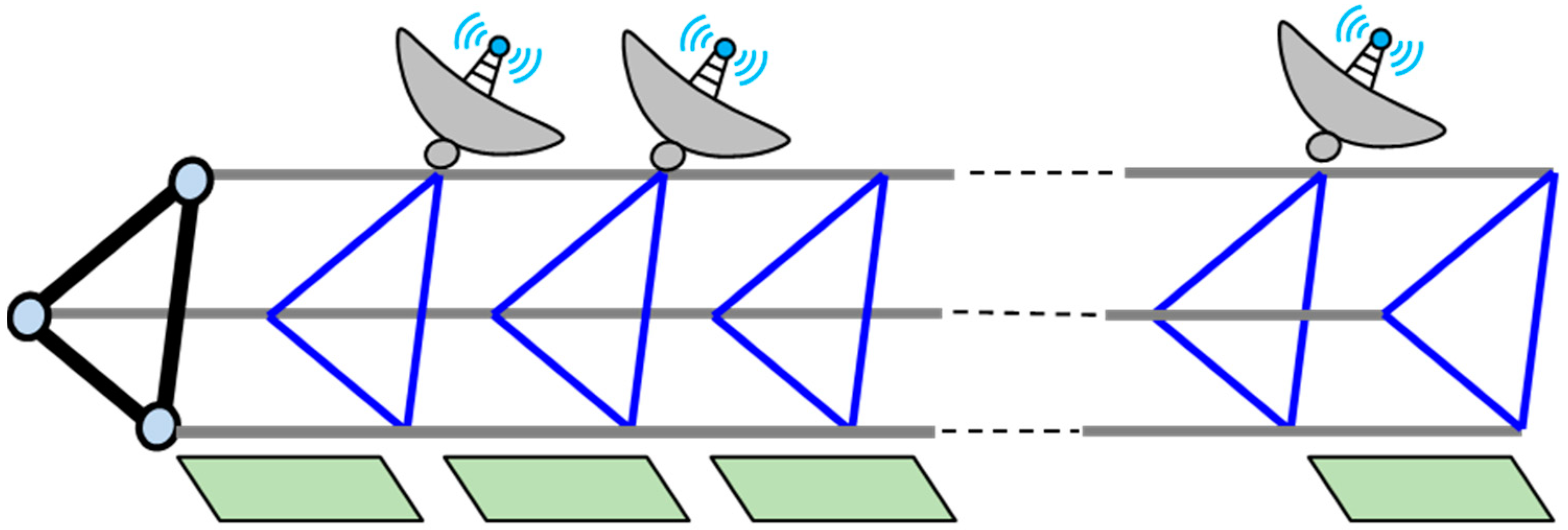
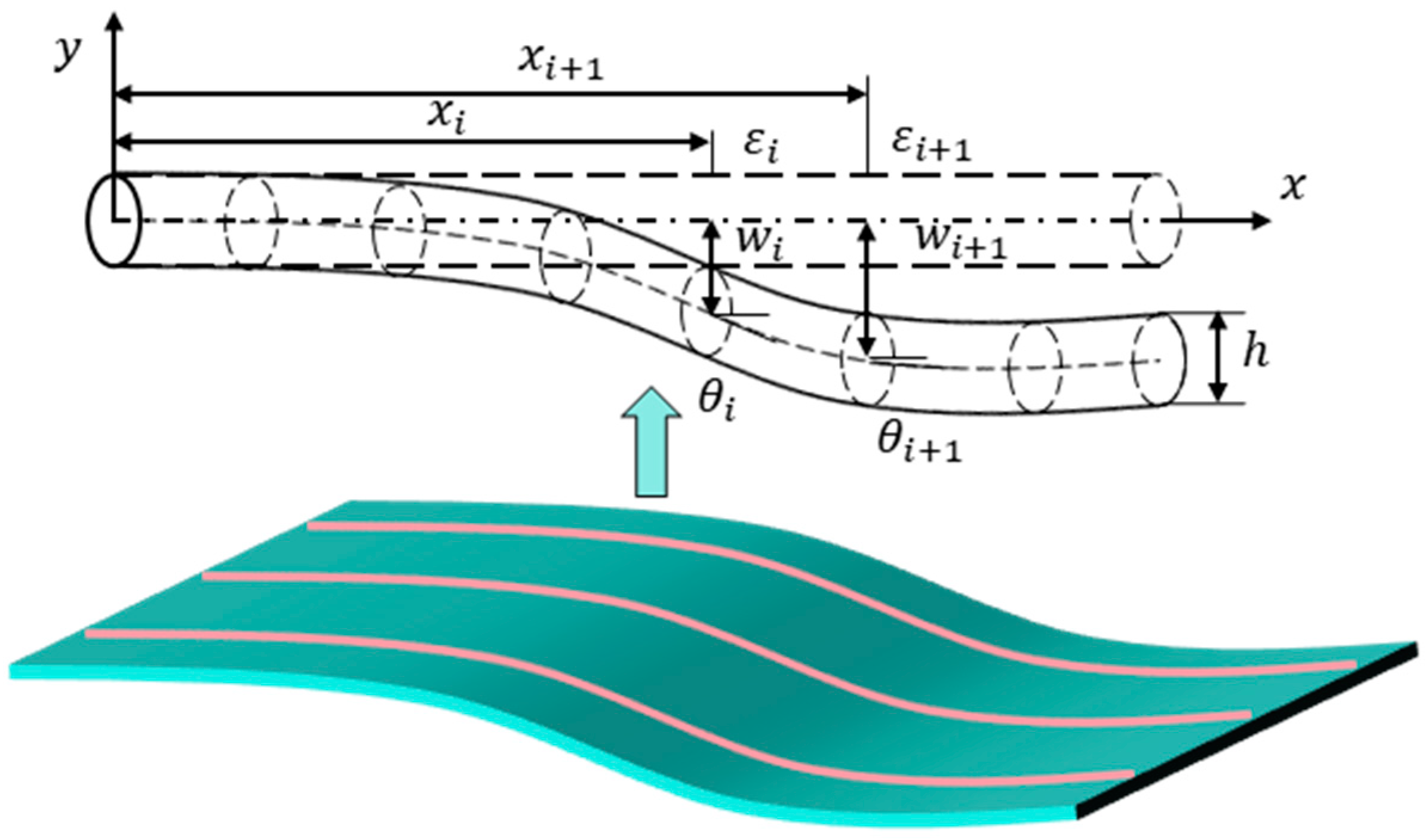





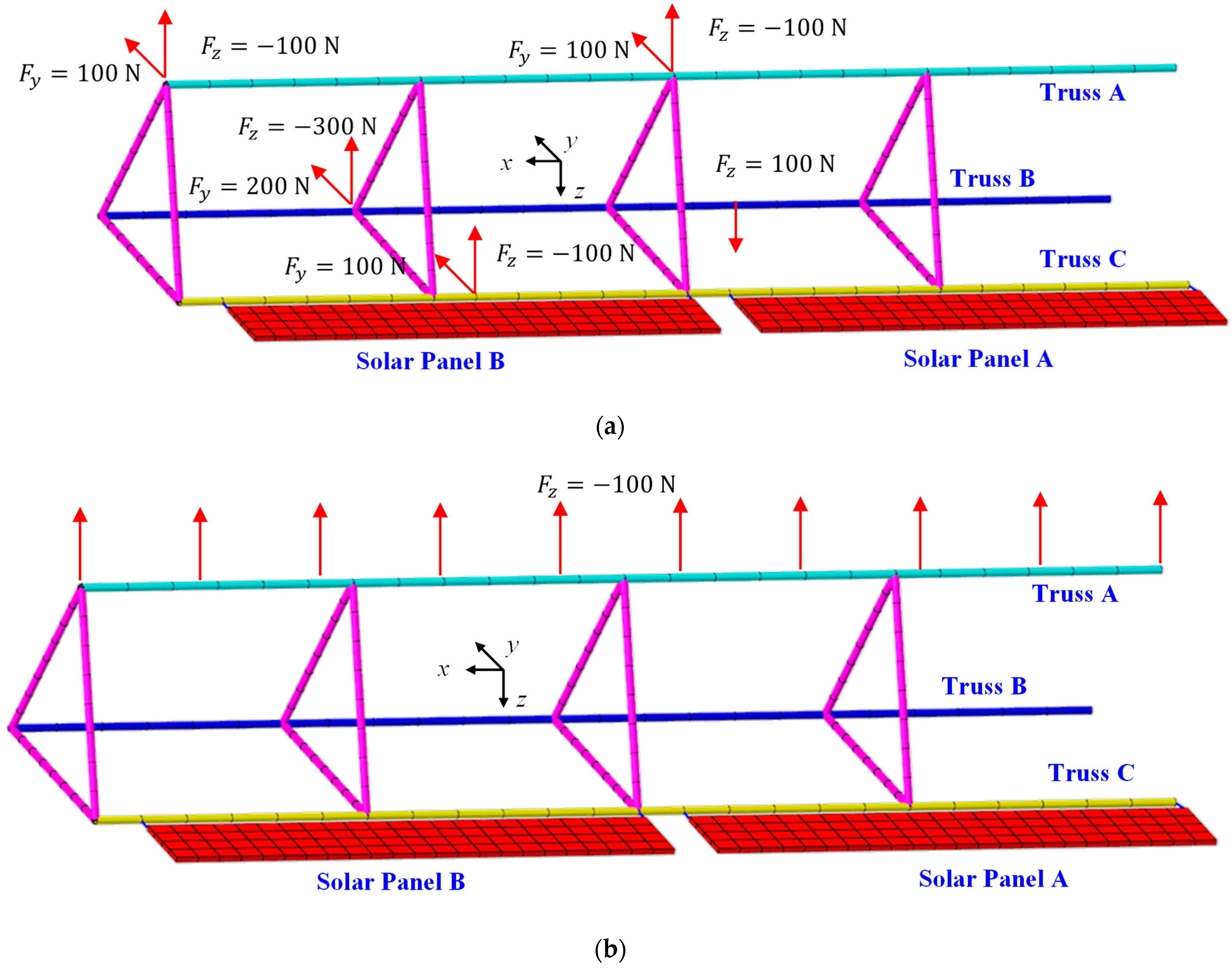
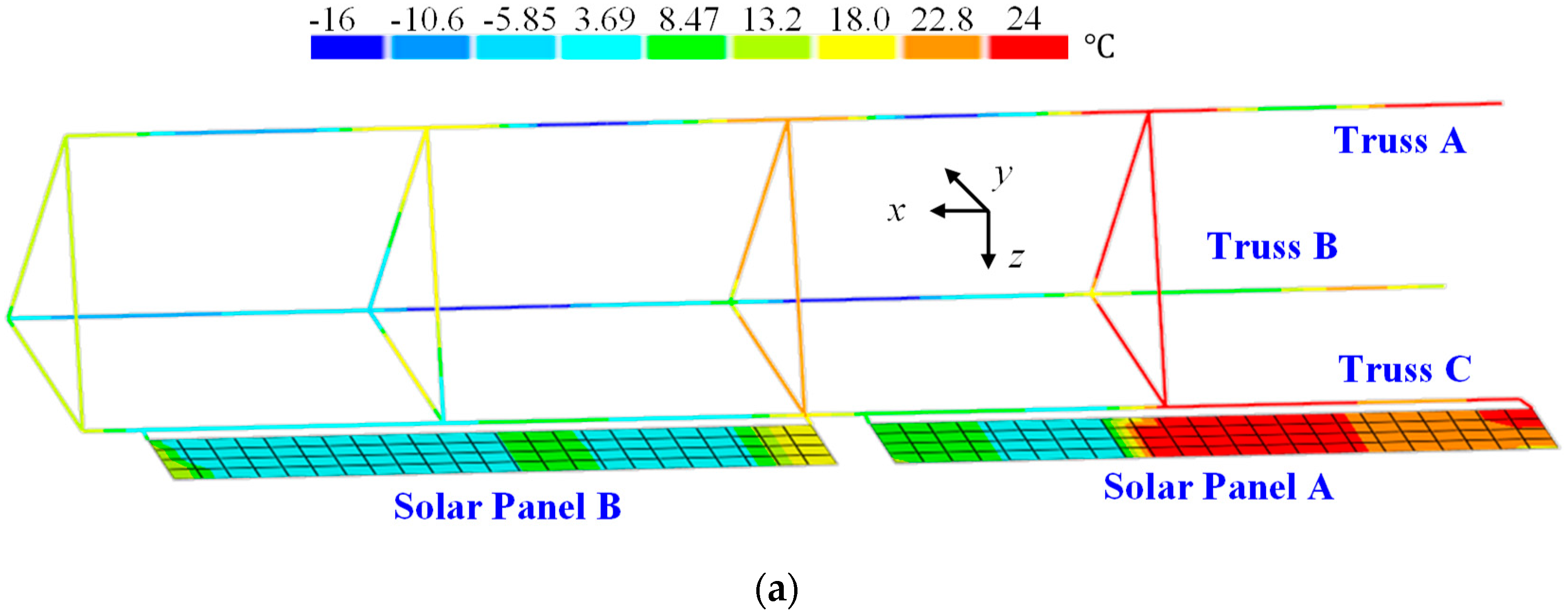

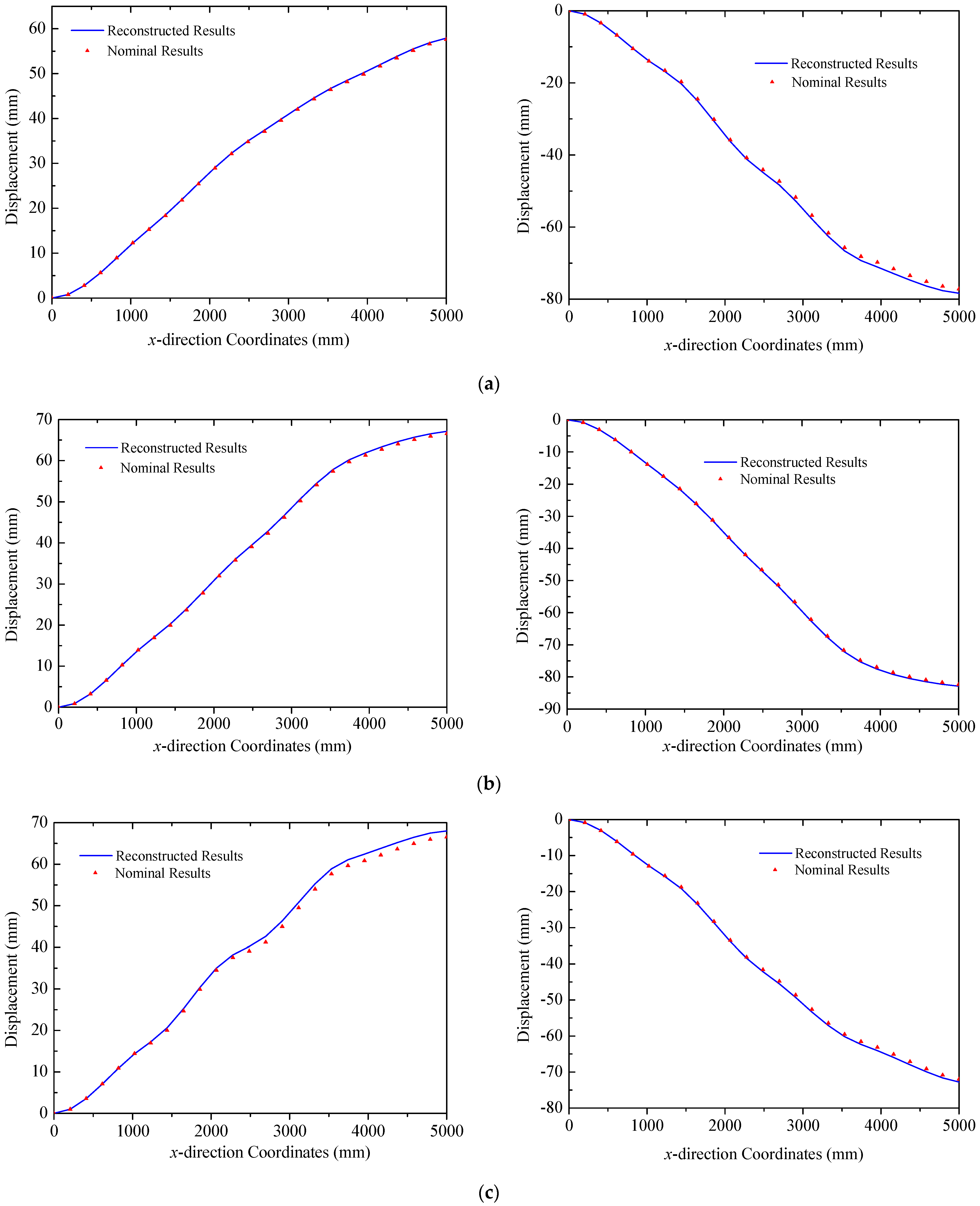
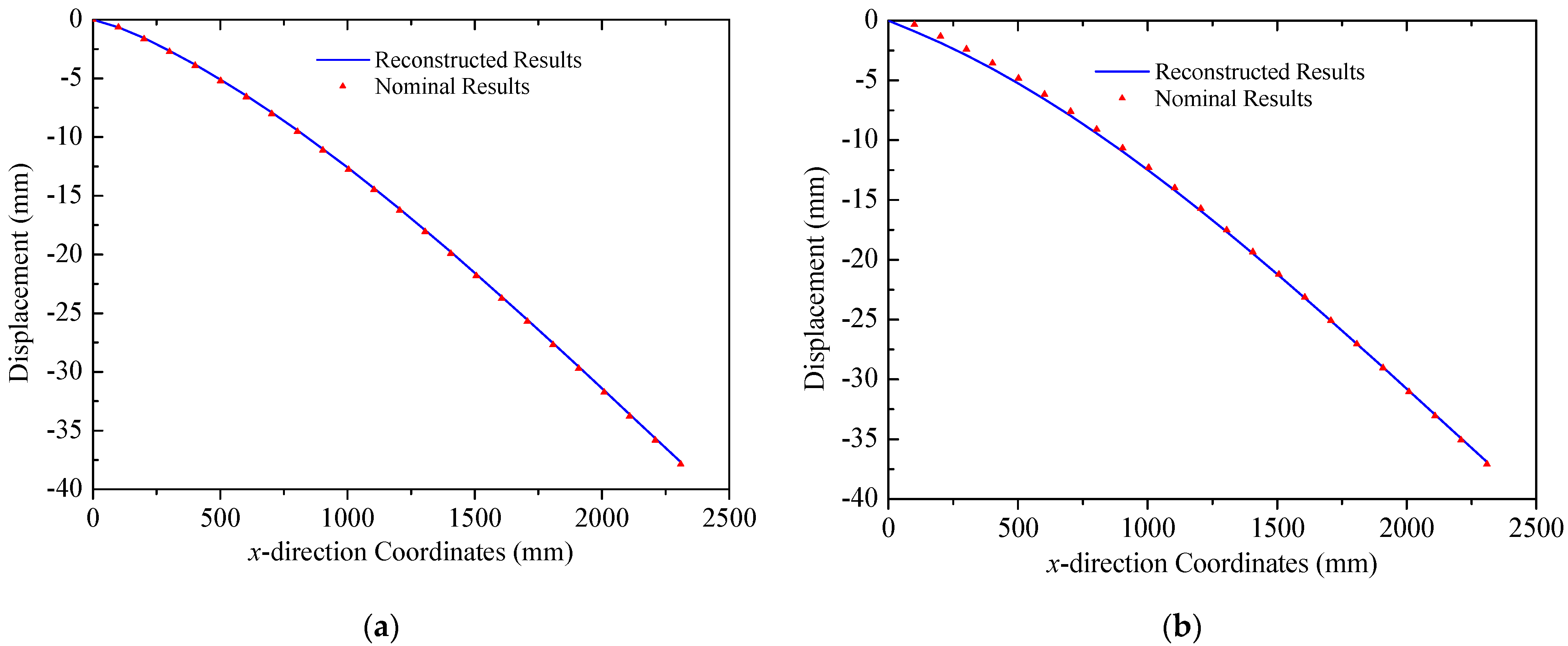
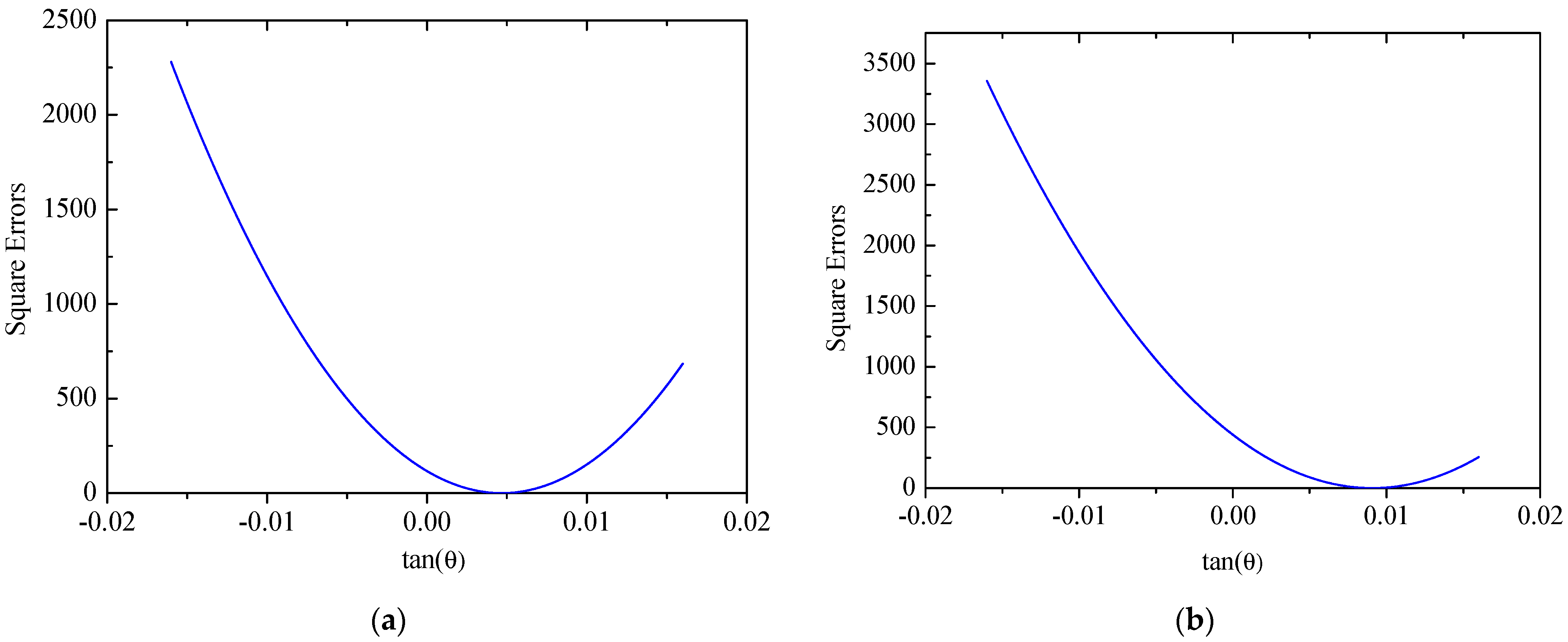
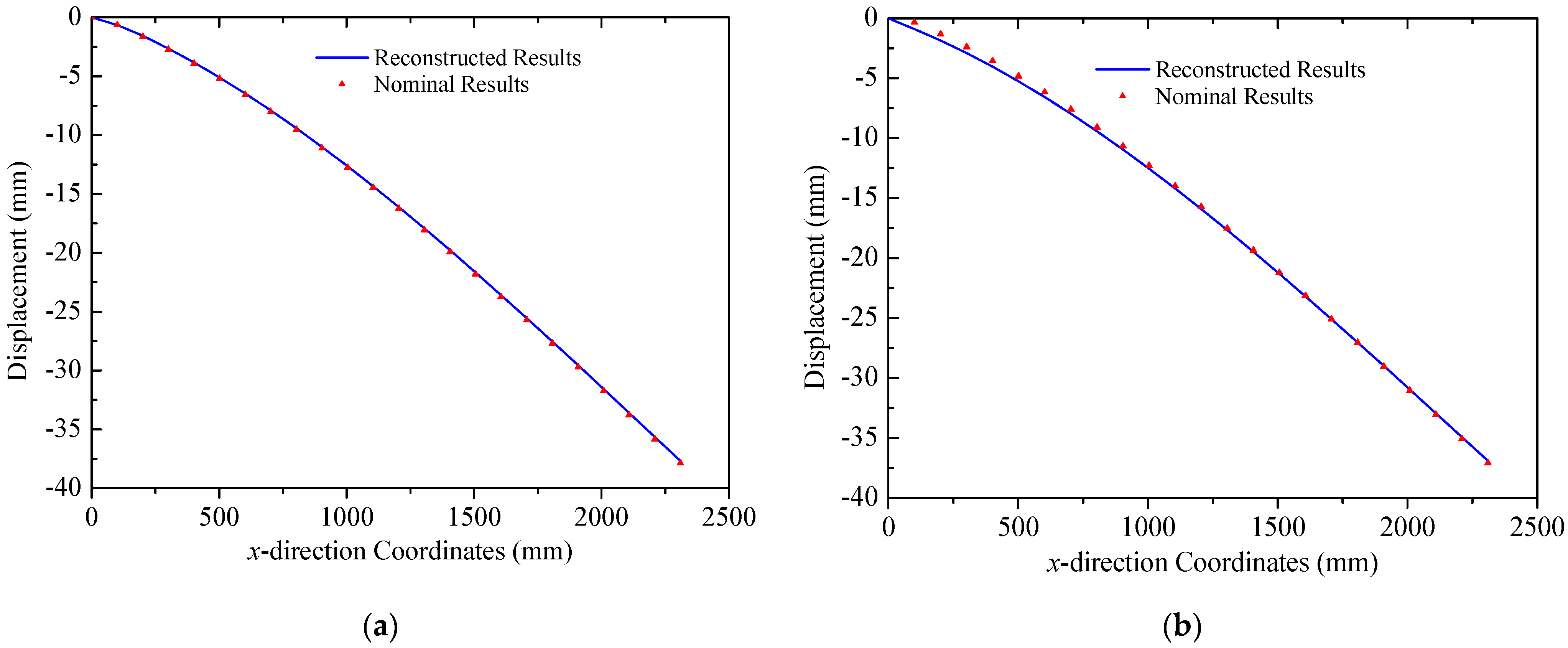
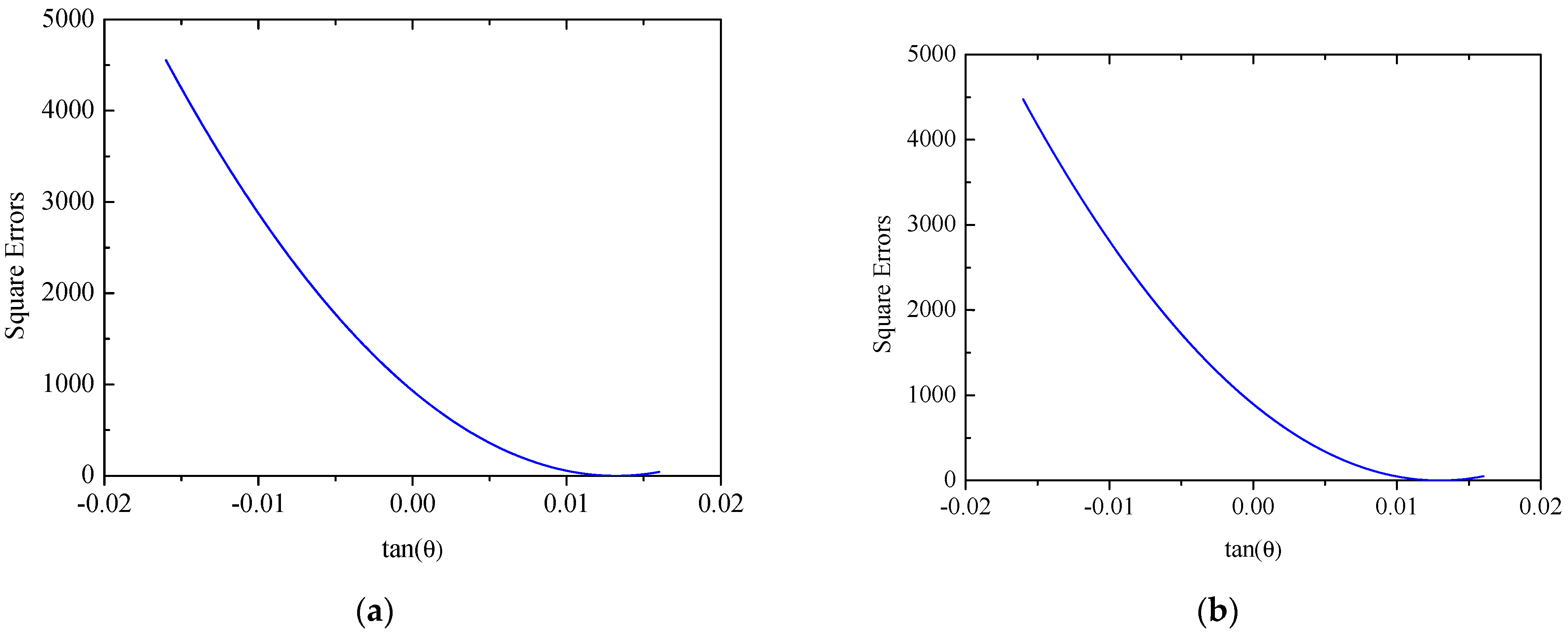
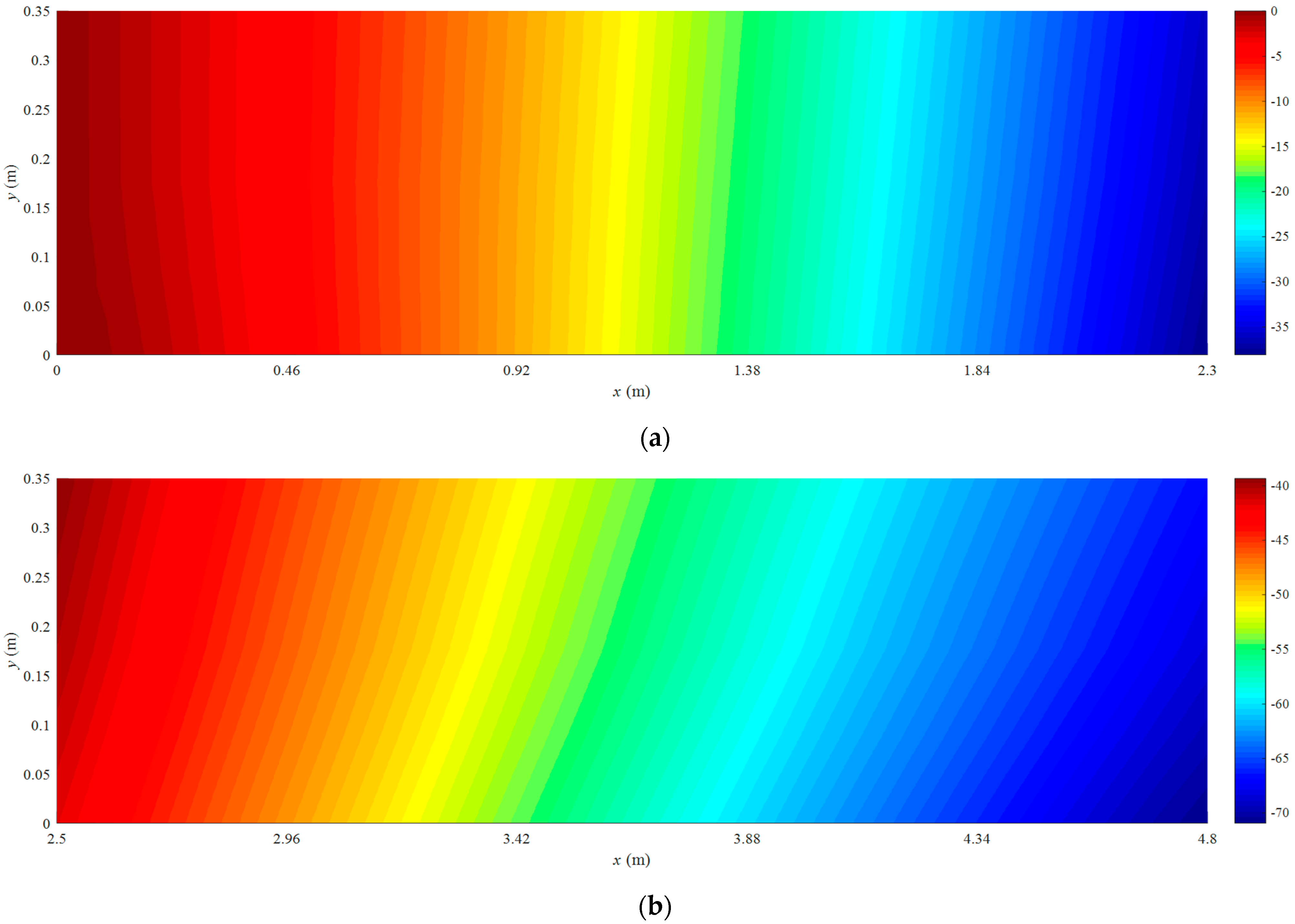
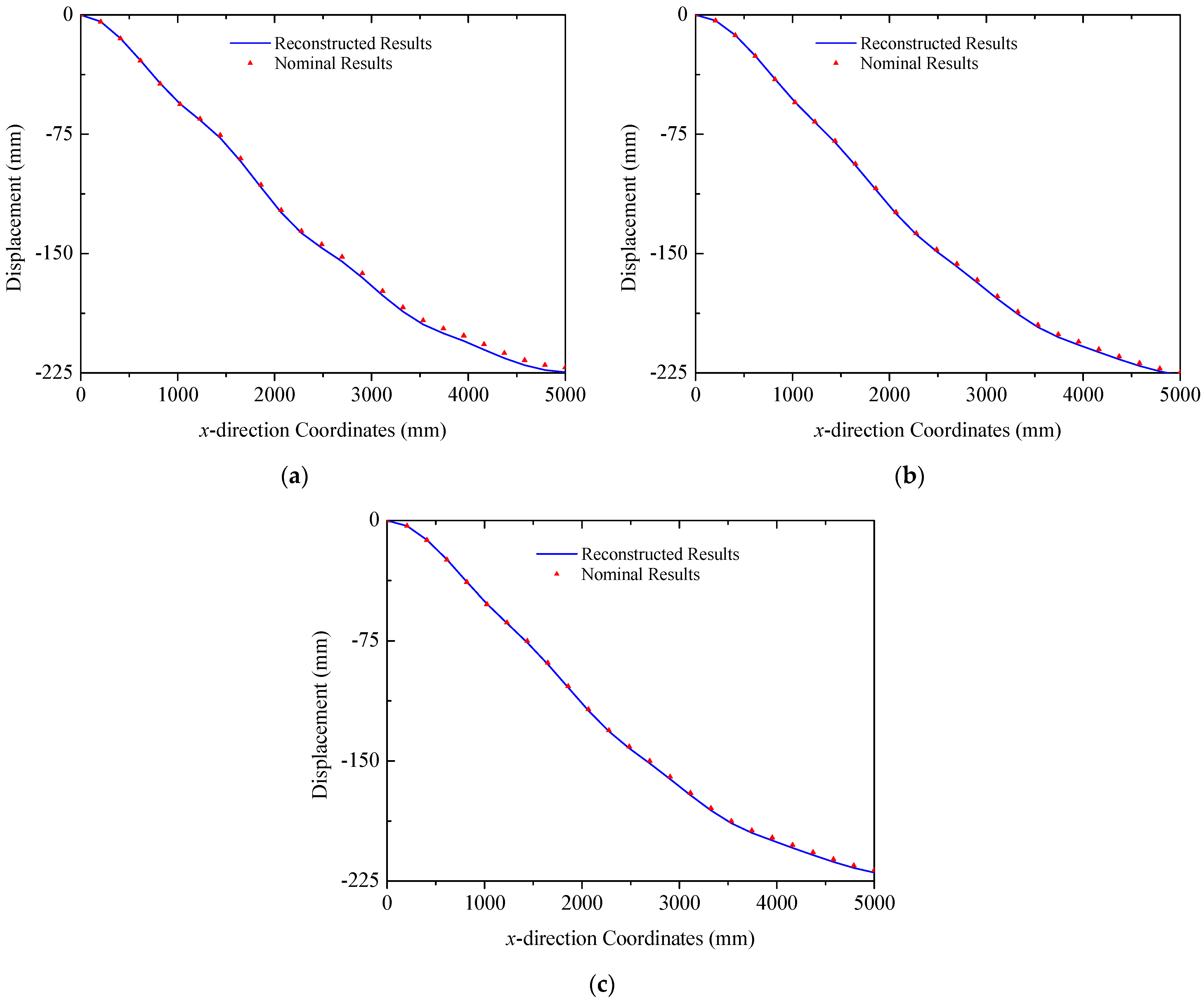
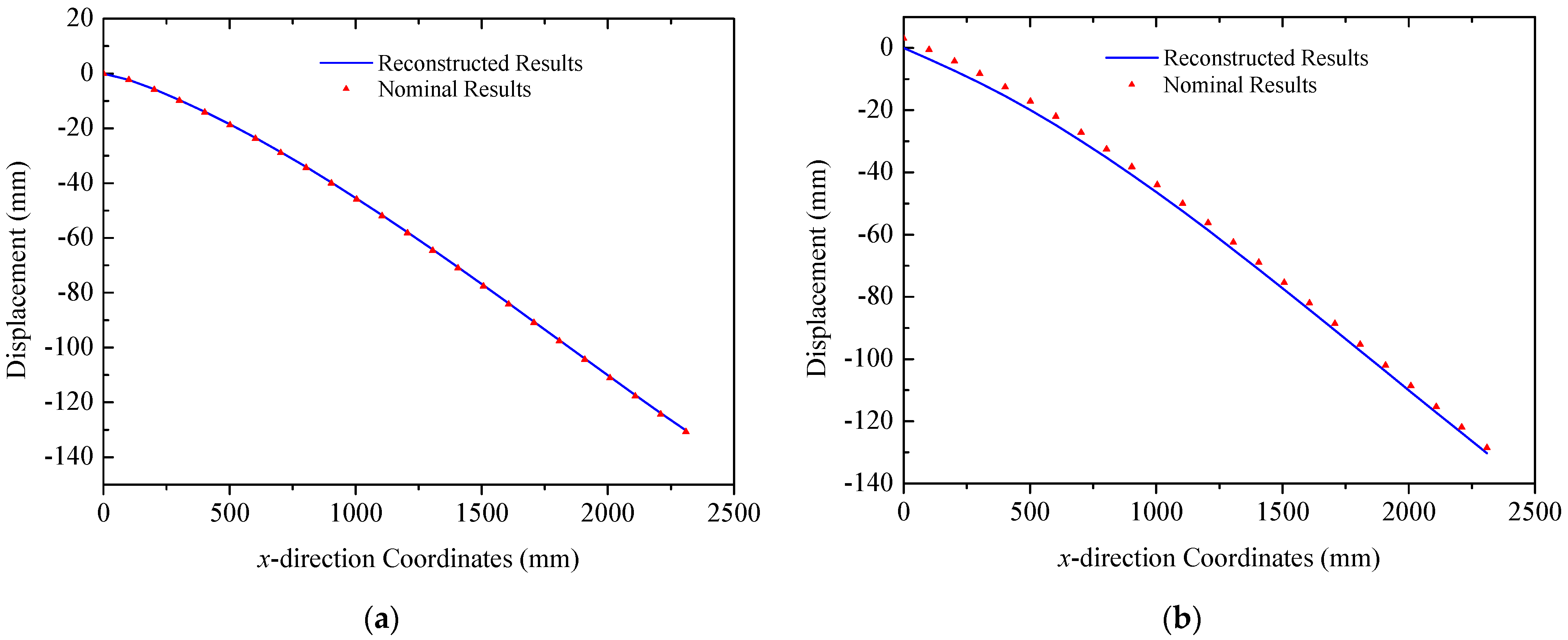

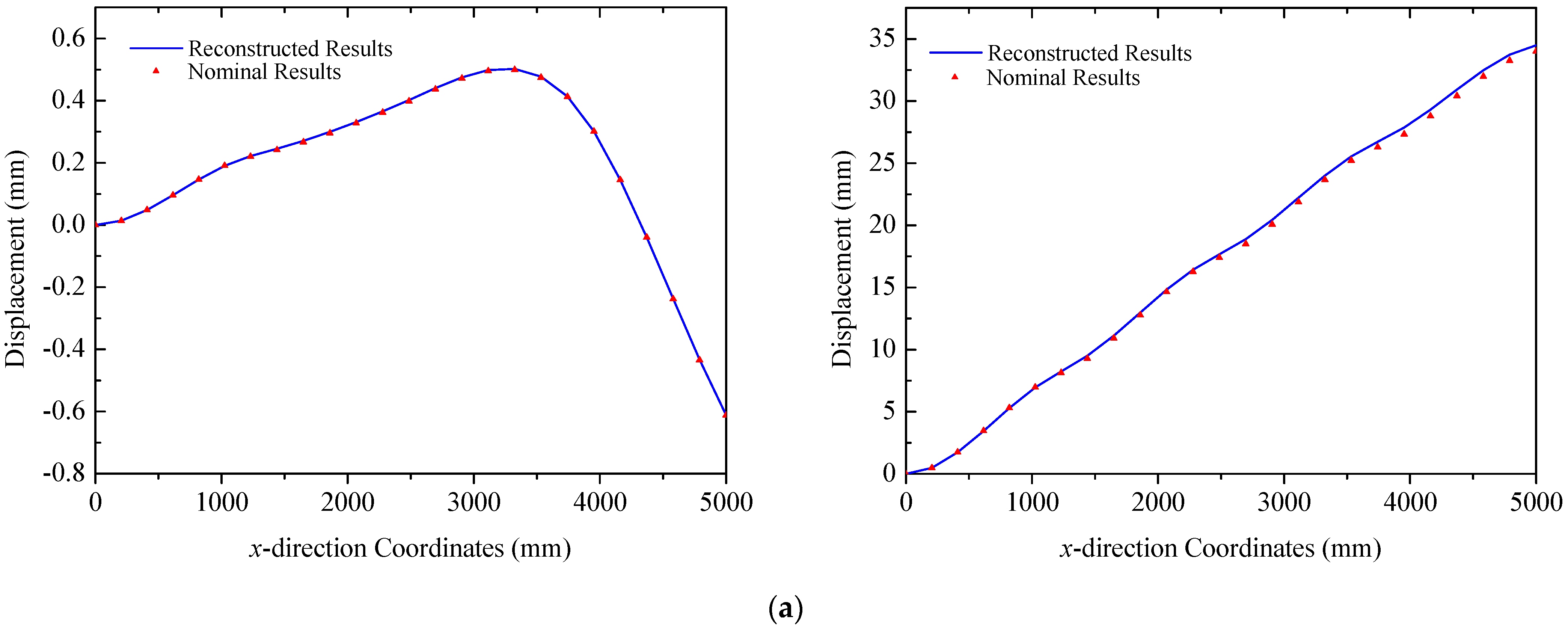
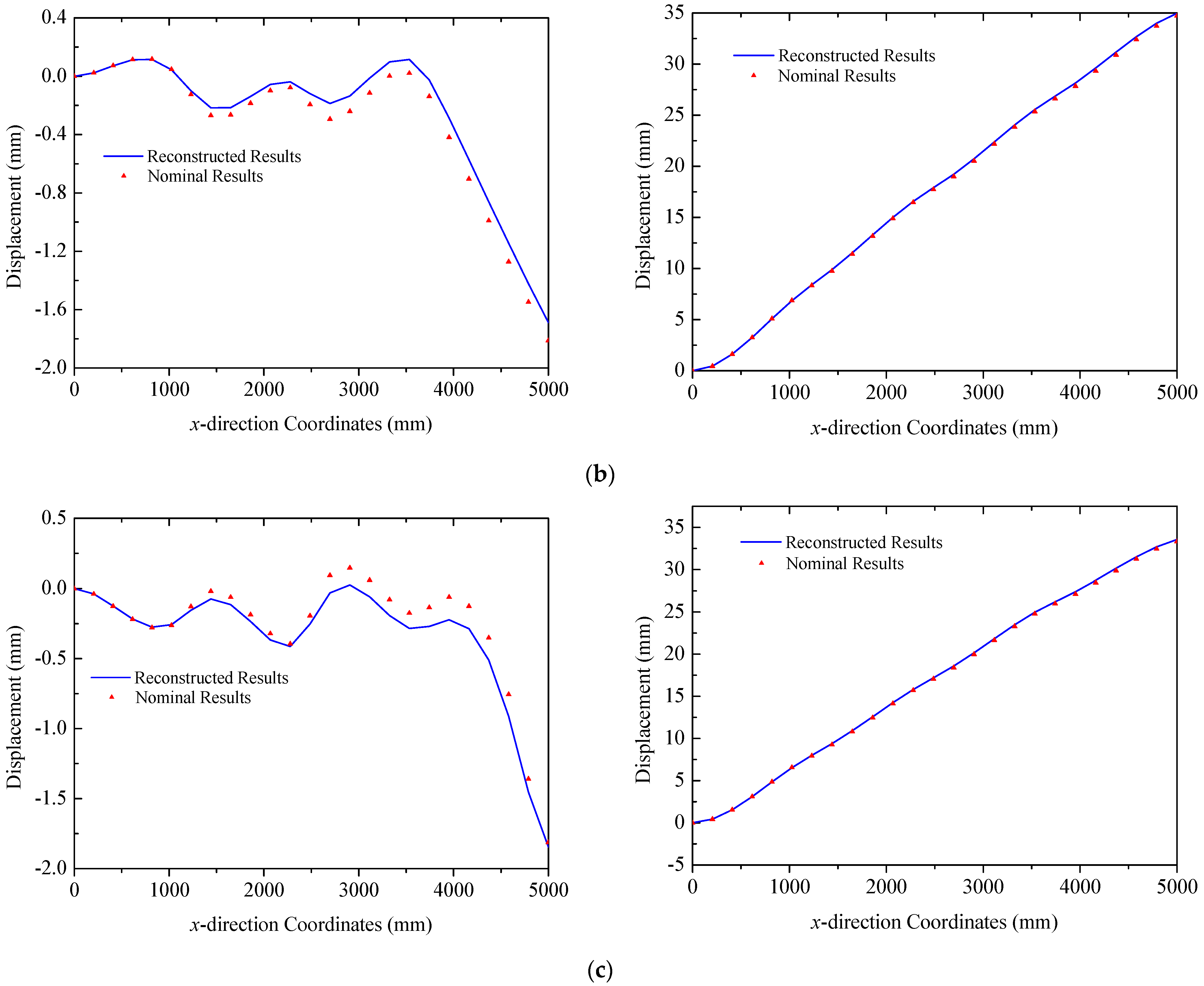
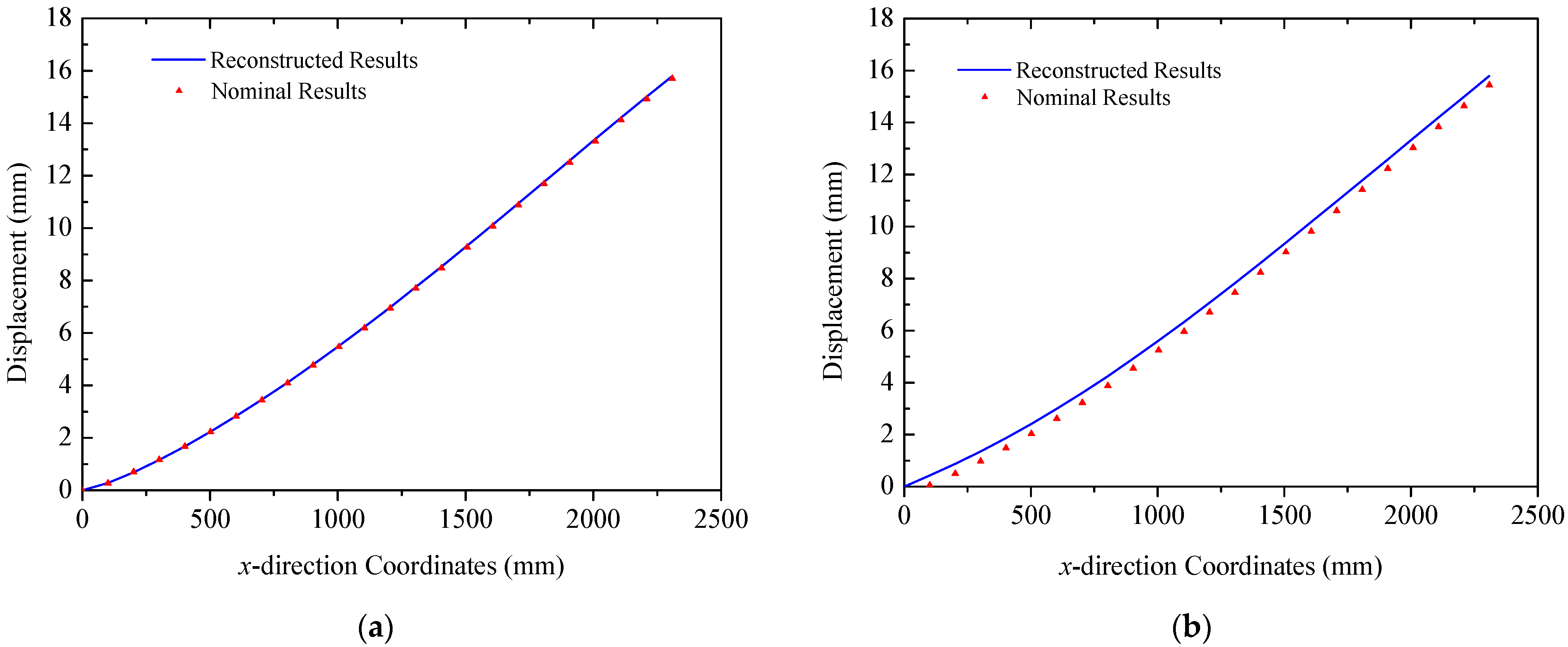

| Material of Truss Structures | ||
| 0,000 Mpa | 4,615 Mpa | .3 |
| 310−7/ | 310−7/ | 3.510−6/ |
| Material of solar panels | ||
| Aluminum Skin | ||
| 0,000 Mpa | .32 | 10−5/ |
| Honeycomb Core | ||
| 0.001 Mpa | 0.001 Mpa | = 0.3 |
| = 0.001 Mpa | = 111 Mpa | = 111 Mpa |
| = 10−5/ | =10−5/ | |
Disclaimer/Publisher’s Note: The statements, opinions and data contained in all publications are solely those of the individual author(s) and contributor(s) and not of MDPI and/or the editor(s). MDPI and/or the editor(s) disclaim responsibility for any injury to people or property resulting from any ideas, methods, instructions or products referred to in the content. |
© 2025 by the authors. Licensee MDPI, Basel, Switzerland. This article is an open access article distributed under the terms and conditions of the Creative Commons Attribution (CC BY) license (https://creativecommons.org/licenses/by/4.0/).
Share and Cite
Yu, Z.; Ma, X.; Zhu, J.; Zhang, D.; Xue, Y.; Huang, P.; Li, Y.; Li, H. A Deformation Reconstruction Strategy for Integrated Truss Structures Subjected to Thermal–Mechanical Load. Sensors 2025, 25, 558. https://doi.org/10.3390/s25020558
Yu Z, Ma X, Zhu J, Zhang D, Xue Y, Huang P, Li Y, Li H. A Deformation Reconstruction Strategy for Integrated Truss Structures Subjected to Thermal–Mechanical Load. Sensors. 2025; 25(2):558. https://doi.org/10.3390/s25020558
Chicago/Turabian StyleYu, Zexing, Xiaofei Ma, Jialong Zhu, Dayu Zhang, Yonggang Xue, Pengfei Huang, Yichen Li, and Hao Li. 2025. "A Deformation Reconstruction Strategy for Integrated Truss Structures Subjected to Thermal–Mechanical Load" Sensors 25, no. 2: 558. https://doi.org/10.3390/s25020558
APA StyleYu, Z., Ma, X., Zhu, J., Zhang, D., Xue, Y., Huang, P., Li, Y., & Li, H. (2025). A Deformation Reconstruction Strategy for Integrated Truss Structures Subjected to Thermal–Mechanical Load. Sensors, 25(2), 558. https://doi.org/10.3390/s25020558






